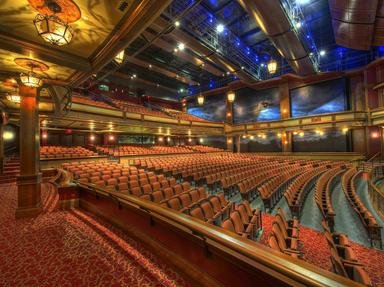Quiz Answer Key and Fun Facts
1. Pre-dating a recent TV show of the same name by several decades, the musical "A Girl Called Jo", was based on which piece of literature?
2. Described as a musical play, and written by Noel Coward, which show is set in a Soho Nightclub and includes the songs "Chase Me Charlie", "In a Boat on the Lake with my Darling" and "Three Juvenile Delinquents"?
3. Which musical, set around a film festival and a member of the paparazzi chasing a story whilst neglecting his girlfriend, includes the songs "The Motor Car Is Treacherous", "Jimmy's Bar" and "Chianti"?
4. The operetta "The Gypsy Princess" is an everyday story about a member of the nobility (Prince Peter) falling in love with a showgirl (i.e., a commoner) and being banned from marrying his true love. Of course, in the real world he would just take her as a mistress, but this is theatre where we cannot allow such things, and it makes a better story this way.
Which of the following songs is NOT from this musical?
5. The summary of the next musical is roughly as follows. Woman falls in love. Paramour goes off to the wars for ten years. When he comes back she dresses as her much younger and non-existent niece, believing that her lover will fall for the younger girl but not her true self as she has aged 10 years.
Trying to woo her soldier boy as her own niece, she finds that her lover is in fact in love with the original woman. As a consequence she has to 'dispose of' her niece (who doesn't exist).
Just an everyday story of musical theatre. But which of these musicals is described by this summary?
6. The next musical was written and first produced during World War 2, and is also set in the same time period. Parted lovers (a French singer and a British spy) are reunited and have to smuggle a scientist back to London. The show includes the songs "Pedro the Fisherman" and "We Must Never Say Goodbye". Which of the following has just been described?
7. Here is another musical with an alter-ego. In this case, a poor student falls in love with a prostitute and creates his alter-ego as a rich elderly gentleman to ensure she spends all her time with him. After a while he finds out the woman is in love with the student persona so he needs to dispose of his elderly gentleman disguise. Sadly, he ends up on trial for the murder of his alter-ego. Which musical does this description match?
8. The musical "The Water Gipsies" is the story of a musician and his two daughters, in particular the younger one who ends up marrying a boatman on the local canal.
Which of these songs is not from this show?
9. Which short musical is sub-titled "Under the Aspidistra"?
10. Which of these musicals is based around the lives and careers of "Flanagan and Allen" (not forgetting "the Crazy Gang")?
Source: Author
paper_aero
This quiz was reviewed by FunTrivia editor
looney_tunes before going online.
Any errors found in FunTrivia content are routinely corrected through our feedback system.
